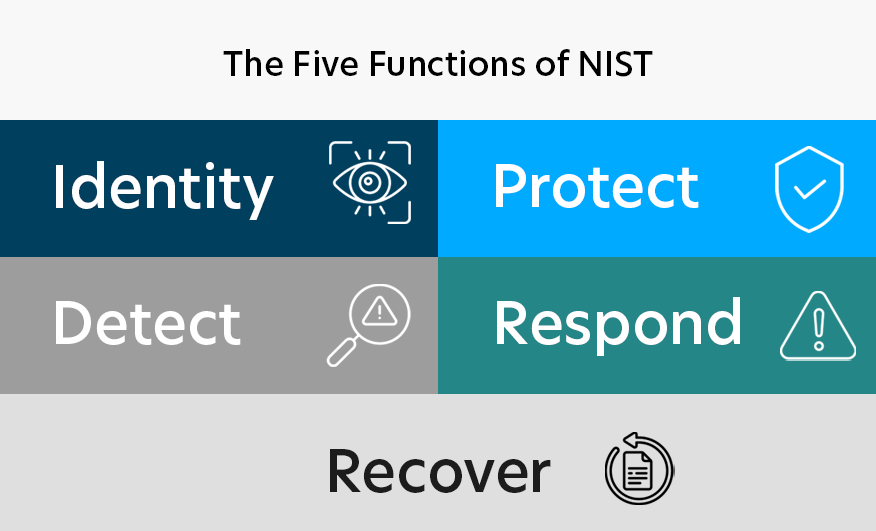Blog ISO 27001 vs NIST Cybersecurity Framework
ISO 27001 vs NIST Cybersecurity Framework

Numerous laws and regulations worldwide require corporations to adopt them to secure their data. NIST CSF and ISO 27001 are two of the most prevalent in North America. While both frameworks intend to safeguard data and strengthen security, they do so differently. Let’s look at the similarities and differences between them.
What Is NIST CSF?
NIST (The National Institute of Standards and Technology) publishes standards, guidelines, and special publications related to the engineering of various technologies. CSF is an example of one such document. Published in 2014, it provides a set of controls to assess organizations’ security strengths and weaknesses. This standard also includes ways for organizations to improve their security.
What Is ISO 27001?
The International Organization for Standardization is represented by the acronym ISO. This group disseminates a collection of guidelines that companies all around the world may utilize to enhance their information security protocols. ISO 27001, published in 2013, has over 250 pages and over 200 clauses that organizations can improve their security.
NIST CSF and ISO 27001 are frameworks that help businesses, large or small, develop stronger information security systems. The two standards contain safeguards that businesses can apply to secure data. These criteria should be evaluated by businesses in terms of their own requirements as well as the prevailing corporate practices.
Prior to establishing a standard, it is imperative for firms to comprehend the reasons behind any shortcomings in their information security systems. If implemented without considering organizational needs, NIST CSF or ISO 27001 can make companies less secure.
Identity
Develop an understanding of how to manage cybersecurity risks to systems, people, assets, data, and capabilities in your company’s context. Comprehending the business’ landscape, vital resources, and related cybersecurity risks enables an entity to focus and organize its endeavors in accordance with its risk mitigation strategy and sector requirements.
Protect
Create security protocols and safeguards that protect your systems from the most threats while minimizing the negative consequences of the rest. In order to protect your systems from most risks and lessen their impacts, you can use tools, personnel training, security systems for data, and systems that automatically monitor to make use of these tools and regulate entrée.
Detect
The first step in detecting a cyber attack is determining what activities should be done if one occurs. The Detect Function aids in the detection of cybersecurity events.
Respond
The Respond Function is one of the functions that may be used during a cybersecurity incident. It helps with containing the consequences of a possible cybersecurity event.
Recover
The Recover Function determines which activities should be carried out to preserve resilience and restore any capabilities or services that have been lost as a result of a cybersecurity event. Minimizing the damage caused by a cybersecurity incident makes timely recovery to normal operations possible.
NIST CSF and ISO 27001 Similarities
NIST CSF and ISO 27001 and complementary frameworks, and both require senior management support, a continual improvement process, and a risk-based approach.
The risk management framework for both NIST and ISO are alike as well. The three steps for risk management are:
- Identify risks to the organization’s information
- Implement controls appropriate to the risk
- Monitor their performance
NIST CSF and ISO 27001 Overlap
Most people don’t realize that most security frameworks have many controls in common. As a result, organizations waste time and money on compliance procedures that are not required. You’ve completed 50% of the NIST CSF when you’ve finished your ISO 27001! What’s even better is that if you implemented NIST CSFs, you’re already 80% of the way to achieving ISO 27001.
The 2010 IAS-HIM Standard also advises organizations to have a centralized tracking of physical assets and their location and identify suppliers that can be held responsible for the maintenance or replacement of those assets. That is in line with Annex A.8.1 of ISO27001 for asset responsibility and ID.AM from NIST CSF.
NIST CSF and ISO 27001 Differences
There are some notable variations between NIST CSF and ISO 27001. NIST was created to help US federal agencies and organizations better manage their risk. At the same time, ISO 27001 is an internationally recognized approach for establishing and maintaining an ISMS. ISO 27001 involves auditors and certifying bodies, while NIST CSF is voluntary. That’s right. NIST is a self-certification mechanism but is widely recognized.
NIST frameworks have various control catalogs and five functions to customize cybersecurity controls. At the same time, ISO 27001 Annex A provides 14 control categories with 114 controls and has ten management clauses to guide organizations through their ISMS.
ISO 27001 is less technical, emphasizing risk-based management that provides best practice recommendations to secure all information.
The ISO 27001 offers a good certification choice for operational maturity organizations. At the same time, the NIST CSF may be best suited for organizations in the initial stages of developing a cybersecurity risk program or attempting to mitigate breaches.
The Costs of NIST CSF and ISO 27001
NIST CSF is available free of charge as it’s voluntary. Implementation can be done at your own pace and cost. However, because ISO 27001 involves audits and certification, there’s often a higher expense. ISO certification is valid for three years, and companies are required to do surveillance audits for two years, and in year three, they’ll complete a recertification audit.
So startups will usually kick start their InfoSec program with NIST and work their way up to ISO 27001 as they scale.
NIST CSF and ISO 27001 Can Work Together
Both frameworks tackle information security and risk management from different perspectives, with varying scopes. Consider the inherent risks of your information systems, available resources, and whether or not you have an existing InfoSec plan before deciding whether to create and use a more well-known framework like ISO 27001 on your own.
ISO 27001, NIST CSF and TrustNet
The close resemblance between NIST and ISO 27001 makes them simple to combine for a more secure security posture. Our ISO 27001 framework, which includes all 138 Annex A controls and the statement of applicability (SoA), can help you choose which controls are essential and provide reasoning. It also contains extra elements relevant to ISO 27001.
With the use of NIST CSF on the rise, more small and medium businesses will likely inquire about compliance. We’ve made that easy in TrustNet.
So it’s not a choice between ISO 27001 and NIST CSF. It’s more a question of how your organization will use the certifications.
Secure your business with TrustNet’s top-tier compliance services. Talk to an expert today.






